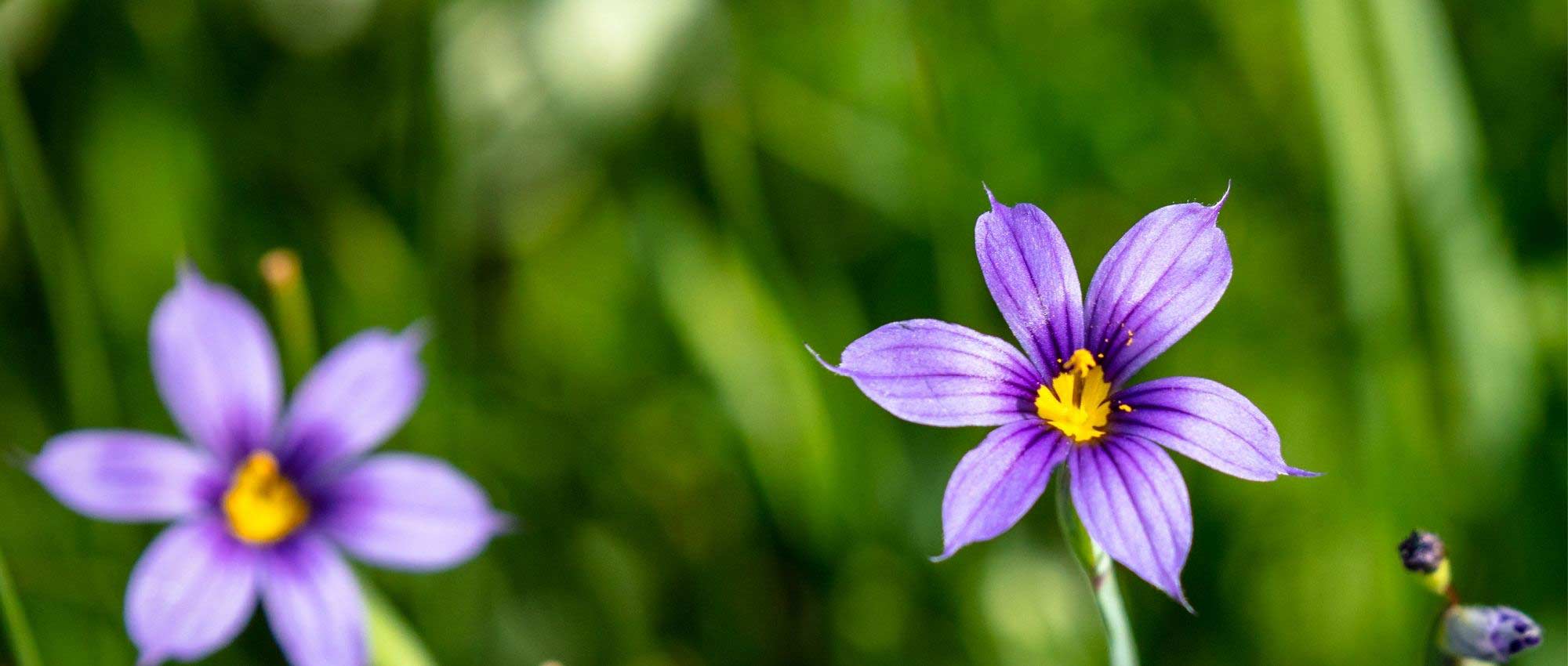
Sisyrinchium, Bermudiana: planting, growing, and caring for
Contents
Sisyrinchium in a nutshell
- Cousin of the Iris, Sisyrinchium is a small perennial that offers charming star-shaped flowers, blue or yellow
- It is a rare plant in cultivation, but it certainly deserves its place in gardens!
- Its delicate flowers are easy to combine with other perennials
- It is perfect in a rockery, a sunny border, or at the edge of a pond
- It requires a warm, sunny position, as well as well-draining soil
- Once established, Sisyrinchium needs almost no maintenance
A word from our Expert
Sisyrinchium are charming perennials with foliage reminiscent of grasses. The leaves are long and slender, bluish-green in colour, and semi-evergreen. In late spring to early summer, they produce delicate star-shaped flowers, often yellow or blue. The most commonly grown is undoubtedly the Sisyrinchium striatum, which offers a very upright flowering habit, with erect flower spikes composed of pale yellow flowers. Due to its soft hue and airy form, it is a very easy plant to combine in the garden! It provides structure while maintaining a light and natural style. The Sisyrinchium californicum, on the other hand, is notable for its small bright yellow star-shaped flowers, with six petals. We also appreciate the Sisyrinchium angustifolium ‘Lucerne’, which bears small blue-mauve flowers.
Sisyrinchium are relatively unknown plants and still quite rare in cultivation! They possess beautiful ornamental qualities. To grow them, the most important factor is to place them in a warm, sunny spot, sheltered from the wind, and in well-draining soil. They are not demanding regarding soil type and are not susceptible to diseases or pests. They only fear cold and stagnant moisture. When happy, Sisyrinchium spread and self-seed spontaneously in the garden… without becoming invasive! They are ideal plants to grow in rockeries or at the edge of ponds.
Botany
Botanical data
- Latin name Sisyrinchium sp.
- Family Iridaceae
- Common name Bermudiana
- Flowering generally in June-July, sometimes until August
- Height between 15 and 90 cm
- Exposure full sun
- Soil type well-drained, light, rather poor
- Hardiness between -10 °C and -15 °C depending on the varieties
Sisyrinchium comprises around 200 species of annual or perennial plants, native to North and South America. They can be found in the wild in various environments: meadows, fallow land, clearings, coastal areas, mountains, etc. Most cultivated species are short-lived perennials, but there are also annual species. Sisyrinchium striatum hails from South America (Chile, Argentina…). It is among the hardiest, tolerating temperatures down to -15 °C in well-drained soil, making it a good garden plant. Sisyrinchium angustifolium is primarily found in wet meadows, clearings, and along riverbanks… It is also known as Sisyrinchium bermudiana, which has earned it the nickname Bermudiana, as it is indeed native to Bermuda, Canada, and the eastern United States.
Sisyrinchium belongs to the large family of Iridaceae (over 2,300 species), which includes herbaceous plants, often rhizomatous or bulbous. In addition to Irises, this family contains many ornamental plants: Crocus, Gladiolus, Freesia, Crocosmia, Ixia, Sparaxis, Watsonia, Chasmanthe…
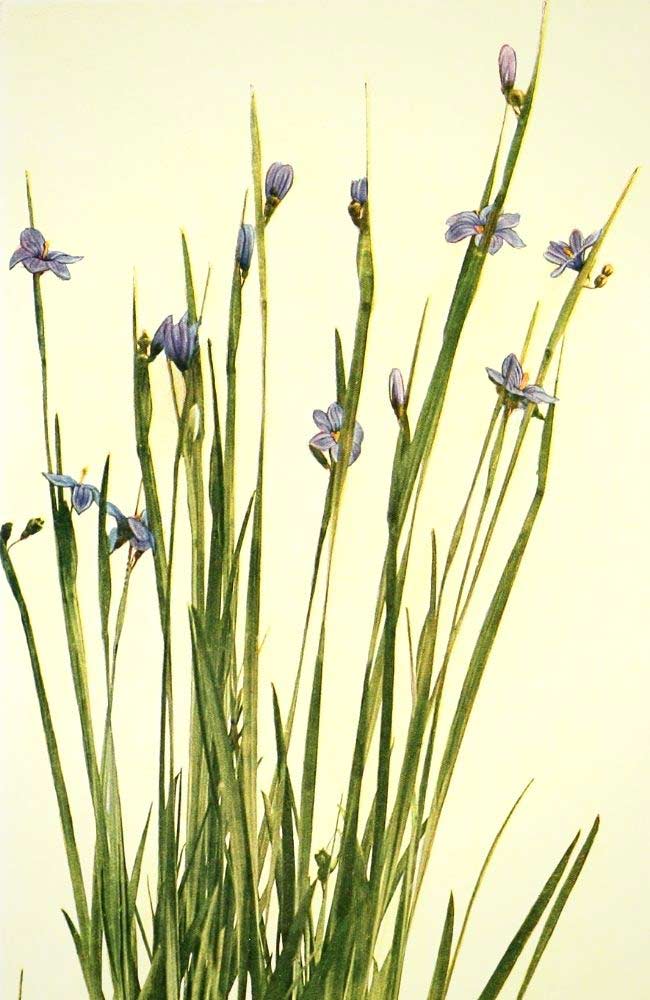
Sisyrinchium angustifolium: botanical illustration
In English, Sisyrinchium is nicknamed Blue-eyed grass: the grass with blue eyes or Golden-eyed grass: the grass with golden eyes, depending on whether it is Sisyrinchium angustifolium, with blue flowers, or S. californicum, with yellow flowers. The Latin name Sisyrinchium comes from the Greek sys: pig and rhynchos: snout, as in their natural habitat, wild pigs dig into the soil in search of Sisyrinchium to consume. The species name S. striatum refers to the small stripes it bears on the underside of the petals, while S. angustifolium means “narrow-leaved.”
Sisyrinchium develops from a short, non-running rootstock. They are short-lived plants, but they tend to self-seed spontaneously without becoming invasive! Moreover, if one wishes to prevent spontaneous seeding, it is sufficient to cut off the faded flowers.
Sisyrinchiums form spreading clumps made up of upright, very fine leaves. These leaves are arranged in a fan shape. Sisyrinchiums measure between 15 and 90 cm tall. Sisyrinchium striatum is among the tallest, as it forms upright floral spikes that are quite vertical. These are slow-growing plants.
Sisyrinchium generally flowers from May – June, and in early summer, sometimes until August. For Sisyrinchium striatum, flowering occurs in June-July.

The flowering of Sisyrinchium angustifolium, Sisyrinchium striatum, and Sisyrinchium californicum (photos The Marmot / Hectonichus / Tom Hilton)
Sisyrinchium offers star-shaped, fine, and delicate flowers. They consist of three petals and three sepals that all look the same (thus referred to as six tepals). They are extended into a tube at the base. The flowers generally measure two to three centimetres in diameter. Insects pollinate the flowers of Sisyrinchium.
The Sisyrinchium striatum bears spikes made up of flowers grouped in successive whorls (5 to 15 flowers inserted together). This results in a tiered and quite graphic flowering, which has the advantage of adding verticality to the flower beds! The flowers are pale yellow, making them relatively easy to combine. The underside of the flowers bears small purplish stripes, which gives it its species name, S. striatum.
The Sisyrinchium californicum, on the other hand, offers a flowering of small bright yellow stars, very luminous. In many other species, the flowers are blue or mauve, with the centre or throat of the flower being bright yellow. This creates a lovely contrast that draws the eye! There is even a variety with pink flowers: ‘Quaint and Queer.’
After flowering, Sisyrinchium produces capsules containing round black seeds. They germinate easily and can self-seed in the garden.
The leaves of Sisyrinchium are linear, very long and fine, resembling grass leaves. They do not exceed 2 cm in width but can reach 40 cm in length, and are bluish-green in colour. They are arranged in a fan shape. Sisyrinchium striatum ‘Variegatum’ has the particularity of bearing variegated foliage. The leaves of Sisyrinchium persist in winter when temperatures remain relatively mild.

The foliage of Sisyrinchium striatum (photos Agnieszka Kwiecień / Cillas) and the fruits – capsules – of Sisyrinchium angustifolium, containing the seeds (photo Gmihail)
The main varieties of Sisyrinchium
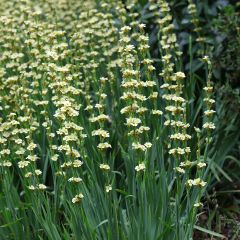
Sisyrinchium striatum
- Flowering time July, August
- Height at maturity 60 cm
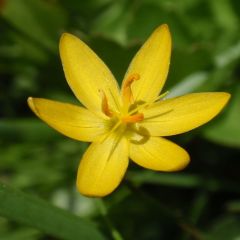
Sisyrinchium californicum
- Flowering time July to September
- Height at maturity 15 cm
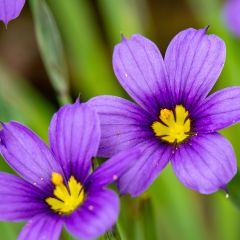
Sisyrinchium angustifolium Lucerne
- Flowering time June to August
- Height at maturity 35 cm
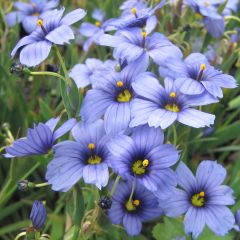
Sisyrinchium angustifolium Devon Skies
- Flowering time August, September
- Height at maturity 15 cm
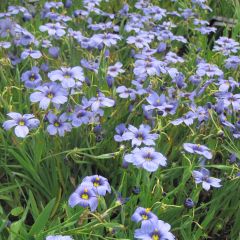
Sisyrinchium bellum
- Flowering time July to September
- Height at maturity 10 cm
Discover other Sisyrinchium
View all →Available in 1 sizes
Available in 1 sizes
Available in 1 sizes
Available in 1 sizes
Available in 2 sizes
Available in 1 sizes
Planting
Where to plant?
Sisyrinchium primarily needs warmth and sunlight! Plant them in full sun, in well-draining, light soil. They tolerate poor, ordinary soils well, but still appreciate fresh soil. Regarding pH, the soil can be neutral or slightly calcareous. We recommend choosing a location sheltered from cold winds. If your soil is heavy and tends to retain water, don’t hesitate to plant on a small mound to allow for better drainage.
If you live in a region with a warm climate, such as the Mediterranean basin, you can plant Sisyrinchium in partial shade. In other regions, it’s better to avoid partial shade, as Sisyrinchium is more floriferous when in the sun!
Sisyrinchiums are perfect for rock gardens, but they can also find their place in borders or at the edge of a pond (be cautious of stagnant moisture: we recommend elevating them above the pond level). This plant is very suitable for seaside gardens and withstands heat and drought.
As it is a small perennial with delicate flowers, don’t hesitate to plant it in masses, installing a large number of young plants together! The effect will be much more impressive.
You can easily grow Sisyrinchium in pots. Additionally, this will allow you to easily shelter it from the cold in winter.
When to plant?
We recommend planting Sisyrinchium in spring, around April-May. However, if you live in a region with a mild climate where the risk of frost is low, you can plant in autumn.
How to plant?
Don’t hesitate to install several Sisyrinchium plants in the same border for a more beautiful effect. Maintain at least 50 cm distance between Sisyrinchium striatum plants, and preferably 30 cm distance for other Sisyrinchiums.
- Prepare a planting hole about twice the size of the root ball.
- Fill it with potting mix mixed with a bit of gravel or coarse sand for drainage.
- Remove the Sisyrinchium from its pot and plant it.
- Replace soil around the clump and firm it with the flat of your hand, but be careful not to bury the collar!
- Water generously.
Continue to water regularly in the weeks following planting, until the Sisyrinchium is well established.
Entretien
Once established, Sisyrinchium requires little maintenance. It is not susceptible to diseases or parasitic issues. However, in heavy soil, its roots may rot, highlighting the importance of good drainage.
Although it tolerates drought, it will appreciate some watering in spring and early summer, which will encourage its flowering.
We recommend applying a layer of mulch around the Sisyrinchium in autumn to protect it from the cold. Similarly, in summer, the mulch will help retain soil moisture for longer.
You can also cut back faded flowers or flower spikes. However, leave some in place to allow the Sisyrinchium to self-seed.
Although they are perennials, Sisyrinchiums have a short lifespan. Generally, they do not root very well in the soil and tend to disappear after a few years. However, they tend to self-seed, particularly Sisyrinchium californicum.
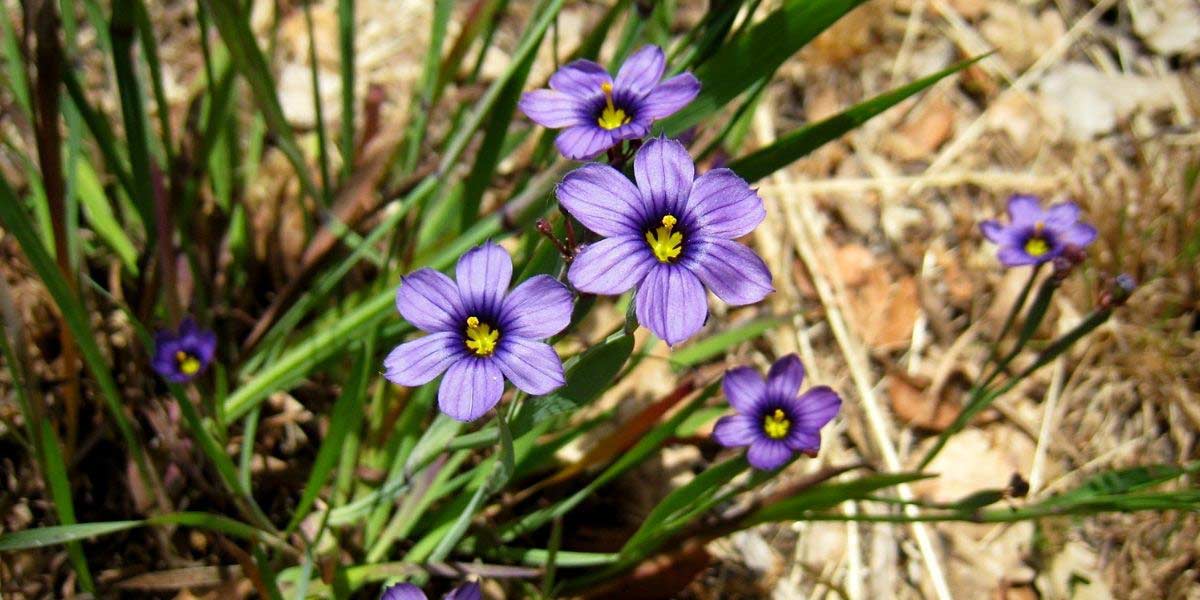
Sisyrinchium bellum (photo Dvortygirl)
Multiplication
We recommend propagating Sisyrinchium by sowing. The seeds germinate easily! Some species even tend to self-seed spontaneously.
Sowing
- Prepare a pot with a light substrate, such as seed compost.
- Sow the seeds.
- Cover them with a thin layer of compost (ideally 6 mm thick).
- Water gently.
- Then place the pots under a cold frame, ensuring that the substrate remains slightly moist until germination.
- As soon as the seedlings are large enough to handle, you can transplant them into individual pots.
- Plant them in the garden the following spring.
Plants obtained from sowing may take two to three years before they start to flower.
Division of Clumps
You can divide clumps of Sisyrinchium in spring or late summer, after flowering. This can be done every two to three years.
- Identify a well-developed clump of Sisyrinchium that has been in place for several years.
- Carefully dig around it to lift it without damaging the roots.
- If necessary, remove soil between the roots, and eliminate any faded flowers, blackened leaves, and dead roots if you see any.
- Separate it into several fragments, ensuring that each has at least a few leaves and roots.
- Replant immediately in a new location or in pots.
- Water generously.
Association
With its very soft pale yellow hue, the Sisyrinchium striatum is very easy to combine in a border! It brings verticality and a delicate, light effect. It will find its place anywhere. It is ideal in a naturalistic garden with a rustic style! Moreover, it self-seeds easily. Plant it in an area of the garden where you intervene little, leaving it very natural. Pair it with other delicate flowers, such as Buenos Aires verbena, purple toadflax, Gaura lindheimeri, Sidalcea, Penstemons, or Salvia pratensis. Also integrate grasses, such as Chinese fountain grass or Stipa pennata. This will give your garden a lovely wild meadow feel!
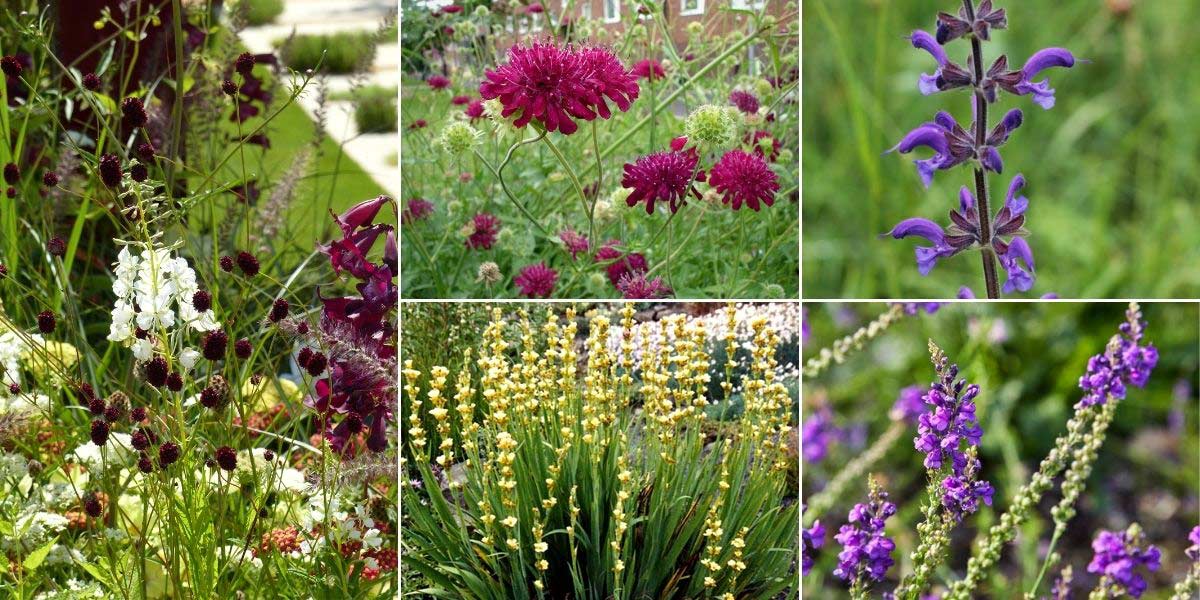
The Sisyrinchium is ideal in a naturalistic, wild garden, alongside other very light flowers! Scene featuring Epilobium angustifolium ‘Album’, Sanguisorba ‘Red Tip’, Penstemon and Pennisetum, Knautia macedonica (photo Epibase), Salvia pratensis (photo Lubaer), Sisyrinchium striatum (photo Ghislain118) and Linaria purpurea (photo C T Johansson)
Conversely, you can also pair it with more impressive blooms, larger and brighter flowers: for example, those of gladioli, dahlias, or roses. The Sisyrinchium will add a touch of lightness alongside them!
The Sisyrinchium striatum also pairs very well with silver or purple foliage: Stachys byzantina, wormwoods, Cynara cardunculus, Cotinus ‘Royal Purple’, Physocarpus, heucheras, Euphorbia amygdaloides ‘Purpurea’… Similarly, with its delicate and natural flowering, it can fit into a romantic garden or a cottage garden. Pair it, for example, with roses, nepeta, campanulas, or alchemilla…
Since they thrive in warm, sunny situations, you can incorporate Sisyrinchiums into a Mediterranean-style garden with a mineral focus. We particularly recommend Sisyrinchium californicum, which is especially suited for seaside gardens. Plant it alongside lavenders, Armeria maritima, agapanthus, Festuca glauca, Eryngiums, santolina, and agaves. You can also create an exotic border with Crocosmias, Kniphofias, and Eucomis.
As the Sisyrinchium is not a very tall plant and has a rather discreet flowering, consider placing it at the front of borders, in front of taller plants. Also, don’t hesitate to plant it in masses for a more impressive effect!
Useful resources
- Discover our range of Sisyrinchium!
- To plant Sisyrinchium in a rockery, check out our guide: “Creating a Rockery: Our Tips for Success”
- Subscribe!
- Contents


































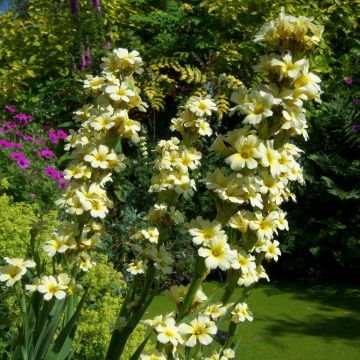


Comments